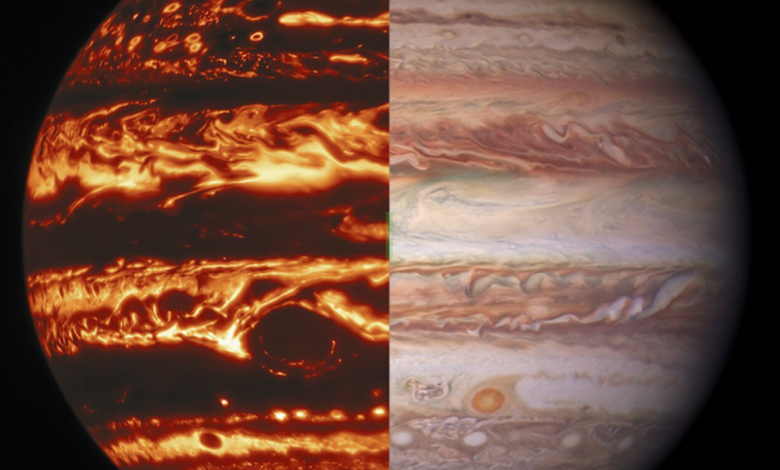New puzzles revealed the red spot

New mysteries have been revealed about Jupiter’s famous ‘red spot’. Jupiter’s Great Red Spot is actually a hostile storm with a “trapped” depth The new results of the planet’s gravity measurements were obtained by NASA’s Juno probe and revealed, in a study published in Science, that Jupiter’s Great Red Spot, despite its large Its size, not as deep as he had imagined. This discovery could explain the reasons for their development and possible disappearance.
“The results of our study testify that the mass of the storm is equal to about half of the entire Earth’s atmosphere And a little less than all the waters of the Mediterranean, the Great Red Spot is represented as an object very similar to a very large disk (its smaller volume is approximately equal to the diameter of the Earth) but rather thin, reminiscent of the characteristics of the greatest terrestrial storms “explains Daniele Durante of the Department of Mechanical and Aerospace Engineering Sapienza University in Rome.
Wisdom researchers remember that Jupiter is the largest planet in the solar system, with a radius of the equator of 71,492 km, It is mainly composed of hydrogen and helium, which is why it is called a “gas giant”. Perhaps the planet’s best-known feature is the Great Red Spot, an anti-vortex storm that was probably discovered by Giandomenico Cassini in 1665. Today this resembles an oval with a size of about 16,000 x 12,000 km, making it the largest storm in the Solar System. In the past 100 years, for reasons that are still unknown, it has decreased significantly. The Great Red Spot still brings with it many questions: one has to do with how deep this storm is sinking into Jupiter.
The Juno probe, built by NASA with an important Italian contribution, answered this as well as other questions about the size of the nucleus. During two upper operations near Jupiter (February and July 2019), NASA’s Juno mission (in orbit around Jupiter since July 5, 2016 to study the formation mechanisms, internal structure, magnetosphere and atmosphere of the gas giant) first observed closely the Great Red Spot . Since the interior of the planet cannot be directly observed, accurate measurements of its gravitational field are used to understand its internal structure, which is an expression of the distribution of mass within the planet.
Measurements of the planet’s gravitational field showed that strong winds from east to west (at speeds of up to 360 km/h), are visible.
Tracking the movement of the clouds, they go to a depth of about 3000 km. Today, The new research, funded in part by the Italian Space Agency (ASI) and coordinated by Marzia Baresi, a former doctoral student at Sapienza and currently a postdoctoral at Caltech/JPL, together with an international group belongs to Daniele Durante and Luciano Ace of the Department of Mechanical and Aerospace Engineering. in Sapienza, shows how the winds of the Great Red Machine have a rather limited vertical penetration depth, equal to about 300 km, which is much less than the depth of the winds blowing in the visible beams of the planet.
The results of the work were published in the journal Science. With a very eccentric orbit, the Juno probe managed to get very close to the gas giant, at an altitude of 4-5 thousand km above the clouds: at these distances it is possible to have a high sensitivity to the gravitational acceleration exerted by structures mainly from the planet’s atmosphere. The spacecraft used the KaT radio science instrument – the Ka-Band Translator, created by Thales Alenia Space-I and with funding from the Italian Space Agency – the heart of the experiment that made it possible to determine the vertical extension of the Great Red Spot.
The Great Red Spot imperceptibly disrupted Juno’s orbit, but the maximum measurement accuracy (up to 0.01 mm/sec) made it possible to capture the very weak gravitational signal and thus estimate the depth at about 300 km.
Juno Measures – concludes Luciano Ice from the Department of Mechanical and Aerospace Engineering at Sapienza University in Rome – They introduced the third dimension to that phenomenon of Jupiter’s atmosphere that caught the attention of many of us, as well as a storm of astronomers for more than three hundred years, which indicates that it is certainly a large-scale surface storm, but very shallow. This new procedure will help to understand their nature, evolution, and possible disappearance.”

“Bacon trailblazer. Certified coffee maven. Zombie lover. Tv specialist. Freelance communicator.”




